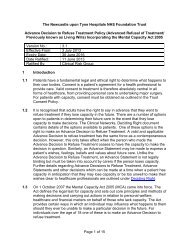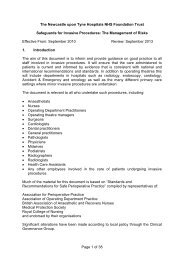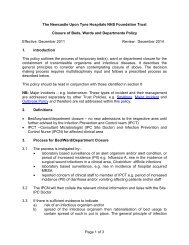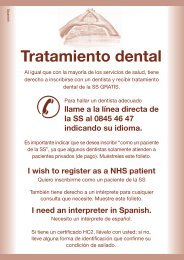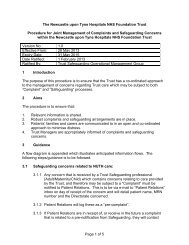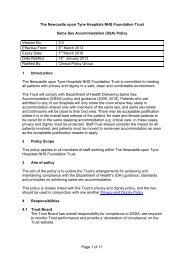Cleaning and Disinfection of Endoscopes Policy - Newcastle Hospitals
Cleaning and Disinfection of Endoscopes Policy - Newcastle Hospitals
Cleaning and Disinfection of Endoscopes Policy - Newcastle Hospitals
- No tags were found...
You also want an ePaper? Increase the reach of your titles
YUMPU automatically turns print PDFs into web optimized ePapers that Google loves.
The <strong>Newcastle</strong> upon Tyne NHS <strong>Hospitals</strong> Foundation Trust<br />
<strong>Cleaning</strong> <strong>and</strong> <strong>Disinfection</strong> <strong>of</strong> <strong>Endoscopes</strong> <strong>Policy</strong><br />
Version No: 5.0<br />
Effective From: 20 June 2013<br />
Expiry Date: 31 December 2015<br />
Date Ratified: 12 March 2013<br />
Ratified By: Decontamination Working Group<br />
1 Introduction<br />
This policy covers the basic principles for cleaning <strong>and</strong> disinfection <strong>of</strong> endoscopic<br />
equipment, which includes:<br />
• Flexible gastrointestinal endoscopes<br />
• Bronchoscopes<br />
• Nasendoscopes/Rhinoscopes (ENT)<br />
• Rigid sigmoidoscopes <strong>and</strong> proctoscopes<br />
• <strong>Endoscopes</strong> inserted into sterile body sites (Choledochoscopes <strong>and</strong> Laparoscopes)<br />
• Transoesophageal Echocardiography (TOE) Probes.<br />
The decontamination procedures must comply with the guidelines produced by the<br />
British Society for Gastroenterology 1 , the British Thoracic Society 2 <strong>and</strong> British Society <strong>of</strong><br />
Echocardiography 3 . There are currently no published guidelines specific to endoscopes<br />
used in the ENT environment. However the Trust has established a central<br />
decontamination process for all flexible endoscopes, <strong>and</strong> ENT scopes will be included in<br />
this process as soon as reasonably practicable.<br />
Any patient undergoing endoscopy may be infected with potentially transmissible<br />
infections such as HIV, hepatitis B, hepatitis C, Salmonella or mycobacteria. The<br />
purpose <strong>of</strong> cleaning <strong>and</strong> disinfection therefore is to prevent the exposure <strong>of</strong> all<br />
individuals to potential pathogens.<br />
Current methods <strong>of</strong> endoscope disinfection are unable to destroy the infecting agent<br />
in CJD/vCJD <strong>and</strong> therefore therapeutic endoscopy should be avoided wherever<br />
possible in patients with known/ suspected or at risk <strong>of</strong> transmissible spongiform<br />
encephalopathy (e.g. CJD, vCJD or UK Plasma recipients). If therapeutic endoscopy<br />
is essential, the Infection Prevention <strong>and</strong> Control Team <strong>and</strong> Endoscopy Matron must<br />
be contacted.<br />
2 <strong>Policy</strong> Scope<br />
This policy applies to all members <strong>of</strong> staff, including locum/agency staff, involved in the<br />
cleaning <strong>and</strong> decontamination process <strong>of</strong> endoscopic equipment. Everyone who uses or<br />
h<strong>and</strong>les any type <strong>of</strong> endoscope must be familiar with the procedures referred to in this<br />
Page 2-1 <strong>of</strong> 17
policy, which therefore includes all satellite areas where endoscopes are used. The<br />
policy also includes guidance <strong>and</strong> recommendations on the safe <strong>and</strong> controlled storage<br />
<strong>of</strong> all flexible endoscopes, using cabinets specifically designed for this purpose. The<br />
policy describes all <strong>of</strong> the processes for the correct cleaning <strong>and</strong> decontamination <strong>of</strong><br />
endoscopes including traceability procedures.<br />
3 Aim <strong>of</strong> <strong>Policy</strong><br />
The aim <strong>of</strong> the policy is to ensure that the cleaning <strong>and</strong> decontamination <strong>of</strong> all<br />
endoscopes follows recognised guidelines, <strong>and</strong> that the Trust is compliant with current<br />
national st<strong>and</strong>ards. This policy is also to ensure that there is complete traceability for<br />
the use, maintenance <strong>and</strong> cleaning processes <strong>of</strong> endoscopes. All <strong>of</strong> the processes<br />
included in this policy are there to protect the patient from potential harm that may be<br />
caused if the equipment used has not been decontaminated to the highest possible<br />
st<strong>and</strong>ards.<br />
4 Duties<br />
It is the responsibility <strong>of</strong> the senior nurse to ensure that this policy is followed. It is the<br />
user who has the ultimate responsibility for certifying that the Automated Endoscope<br />
Reprocessor (AER) is fit for use (see CFPP 01-06 4 ). The Trust’s Estates Department is<br />
responsible for ensuring that all endoscopes <strong>and</strong> AER’s are correctly maintained, either<br />
in-house or by a contractor, <strong>and</strong> appropriate maintenance records are kept. The Trust’s<br />
Estates Department must also ensure that the HPA are contracted to carry out the<br />
weekly testing <strong>of</strong> the final rinse water, <strong>and</strong> must circulate the results to all end users,<br />
Head <strong>of</strong> Estates <strong>and</strong> IPC. All users <strong>of</strong> endoscopes are responsible for examining the<br />
scopes for any damage prior to use on a patient (see section 5.1).<br />
5 Definitions<br />
• AER: (Automated Endoscope Reprocessor) Washer-Disinfector machine capable <strong>of</strong><br />
disinfection <strong>and</strong> rinsing to a reproducible st<strong>and</strong>ard <strong>and</strong> where the performance can<br />
be validated <strong>and</strong> verified<br />
• Manual <strong>Cleaning</strong>: The physical removal <strong>of</strong> infectious agents (but not necessarily<br />
their destruction) <strong>and</strong> the organic material which can shield them from disinfectants,<br />
e.g. a neutral detergent or enzymatic cleaner in warm water<br />
• <strong>Disinfection</strong>: The process <strong>of</strong> reduction in viable infectious agents to a safe level, e.g.<br />
by using chlorine dioxide (Tristel ® ) or Peracetic Acid (Gigasept ® )<br />
• Decontamination: The process <strong>of</strong> cleaning combined with disinfection or sterilisation<br />
that makes medical devices safe for reuse<br />
• ESC: (Endoscope Storage Cabinet) A cabinet, which is specially designed to store<br />
endoscopes in a clean <strong>and</strong> dry environment, using HEPA (High Efficiency<br />
Particulate Air) filtration<br />
• Tristel Pre-Clean Wipe: Impregnated s<strong>of</strong>t wipe with low-foaming surfactant system<br />
combined with triple enzymes, producing ultra-low surface tension for rapid<br />
cleaning.<br />
Page 5-2 <strong>of</strong> 17
5.1 Disinfectants <strong>and</strong> manual cleaning agents<br />
<strong>Cleaning</strong> chemicals can be damaging to instruments <strong>and</strong> processing equipment,<br />
therefore external surfaces <strong>of</strong> flexible endoscopes <strong>and</strong> equipment must be<br />
examined daily prior to use. Any evidence <strong>of</strong> damage must be reported to the<br />
senior nurse <strong>and</strong> documented in the department’s own ‘Endoscope Log Book’<br />
which is held in each <strong>of</strong> the Trust’s Central Decontamination Units <strong>and</strong> all satellite<br />
units.<br />
The chemicals used in the AERs achieve high level disinfection. They have a role<br />
to play where autoclaving is not possible in the processing <strong>of</strong> flexible endoscopes<br />
(e.g. flexible Cystoscopes, Hysteroscopes etc), which are required to be ‘highlevel<br />
disinfected’ before use.<br />
Water for rinsing: AERs use reverse osmosis (RO) water systems or tap water<br />
filtered through a bacteria retaining filter, which is an alternative to the use <strong>of</strong><br />
sterile water.<br />
5.2 <strong>Disinfection</strong> <strong>and</strong> Sterilisation<br />
It cannot be emphasised too strongly that thorough manual cleaning <strong>of</strong> an<br />
endoscope prior to disinfection is the most important means <strong>of</strong> removing potential<br />
pathogens. Satisfactory cleaning will remove the vast majority <strong>of</strong> microorganisms,<br />
plus organic matter that would otherwise protect bacteria <strong>and</strong> viruses against the<br />
action <strong>of</strong> a disinfectant. In addition blood, mucus <strong>and</strong> other organic material is<br />
“fixed” in place by disinfectants, which makes future cleaning more difficult.<br />
<strong>Cleaning</strong> & disinfection <strong>of</strong> endoscopic equipment correctly is essential <strong>and</strong><br />
e v e r y o n e involved in this process must be familiar with the guidance <strong>and</strong><br />
strictly adhere to it. Adhering to the set guidelines reduces the risk <strong>of</strong> cross<br />
infection to both patients <strong>and</strong> staff.<br />
There are many different types <strong>of</strong> instruments, which have the common feature<br />
in that they are inserted into sterile <strong>and</strong> non-sterile areas <strong>of</strong> the body. They<br />
include:<br />
• Rigid Arthroscopes <strong>and</strong> Rigid Laparoscopes:<br />
These instruments must be sterile <strong>and</strong> therefore must<br />
be autoclaved<br />
• Rigid Hysteroscopes:<br />
These instruments must be sterile <strong>and</strong> therefore must<br />
be autoclaved<br />
• Flexible Hysteroscopes:<br />
These instruments will not withst<strong>and</strong> autoclaving. After thorough manual<br />
cleaning, they should be processed in a suitable AER<br />
Page 5.2-3 <strong>of</strong> 17
• Flexible Choledochoscopes <strong>and</strong><br />
laparoscopes:<br />
These instruments must be sterile <strong>and</strong> will not withst<strong>and</strong> autoclaving. After<br />
thorough manual cleaning, they should be processed by gas sterilisation, as<br />
recommended by the manufacturer<br />
• Cardio Telescopes:<br />
These instruments are used in conjunction with a rigid bronchoscope<br />
therefore must be autoclaved<br />
• Mediastinoscopes:<br />
These instruments must be sterile <strong>and</strong> must therefore<br />
be autoclaved<br />
• Rigid Cystoscopes:<br />
These instruments must be sterile <strong>and</strong> must therefore<br />
be autoclaved<br />
• Flexible Cystoscopes:<br />
These instruments will not withst<strong>and</strong> autoclaving. After thorough manual<br />
cleaning, they should be processed in a suitable AER<br />
• Nasendoscopes:<br />
These instruments will not withst<strong>and</strong> autoclaving. After thorough manual<br />
cleaning, they should be processed using an AER. If there is no access to an<br />
AER the Tristel 3 Wipe System must be used, as described in section 6.4<br />
• Rhinoscopes:<br />
These are rigid scopes used in ENT <strong>and</strong> are autoclaved<br />
• TOEs (Transoesophageal Echocardiography Probes)<br />
These instruments will not withst<strong>and</strong> autoclaving. After thorough manual<br />
cleaning, they should be processed using an AER (this is the gold st<strong>and</strong>ard,<br />
but is not achieved routinely). Reprocessing <strong>of</strong> TOE probes is currently under<br />
review at the time <strong>of</strong> writing this policy.<br />
6 Procedures<br />
The use <strong>of</strong> Automated Endoscope Reprocessors is not a substitute for effective manual<br />
cleaning prior to disinfection. St<strong>and</strong>ard Precautions must be adhered to at all times <strong>and</strong><br />
Personal Protective Equipment (PPE) including gloves, apron, goggles / face protection<br />
must be worn. During manual cleaning phase, forearms should be protected.<br />
Page 6-4 <strong>of</strong> 17
6.1 <strong>Cleaning</strong> <strong>and</strong> <strong>Disinfection</strong><br />
Procedure room - Immediately after removal from the patient <strong>and</strong> whilst still<br />
connected to the light source:<br />
• Wipe down insertion tube with gauze swab in warm water (between 24 0 C –<br />
30 0 C) <strong>and</strong> enzymatic cleaner<br />
• For GI endoscopes, remove air/water (blue) valve <strong>and</strong> replace with flushing<br />
valve, depress for 10-15 seconds to eject any refluxed debris. If blockage noted,<br />
use appropriate blockage removal device immediately<br />
• If endoscope has a suction channel, depress suction valve for 10-15<br />
seconds, with insertion end <strong>of</strong> endoscope under level <strong>of</strong> water to remove debris<br />
from suction/biopsy channel<br />
• Disconnect from the light source<br />
• If video endoscope, attach video cap – this is essential <strong>and</strong> must be attached<br />
• Transport dirty endoscope to cleaning room in the appropriate covered tray.<br />
<strong>Cleaning</strong> Room - Leak Testing:<br />
• Fill the sink to the marked level with warm water <strong>and</strong> a pre-measured dose<br />
<strong>of</strong> enzymatic cleaner as per instructions<br />
• If video endoscope, check the water resistant video cap is attached, as the<br />
videoscope must not be put in water without the water resistant video cap<br />
attached<br />
• Attach leak tester <strong>and</strong> switch on<br />
• Immerse endoscope in sink <strong>of</strong> warm water <strong>and</strong> perform leak test<br />
• If endoscope shows a leak (bubbles in the water) – dry, wipe down with<br />
alcohol wipe, do not proceed any further. Do not place in the AER. The<br />
endoscope needs to be sent for repair (follow the process for sending for repair)<br />
• If no leak apparent – proceed with cleaning process.<br />
External <strong>Cleaning</strong> Process:<br />
• Remove all valves <strong>and</strong> discard disposable biopsy cap<br />
• Clean air/water <strong>and</strong> suction valves with the disposable cleaning brush –<br />
these must be kept as a unique set with the particular endoscope<br />
• Use 5ml syringe & connector to flush auxiliary channels (if applicable) wash<br />
outside <strong>of</strong> endoscope thoroughly with enzymatic cleaner<br />
• Brush distal tip paying particular attention to the air/water nozzle<br />
• If endoscope has no internal channels - Wash outside <strong>of</strong> endoscope<br />
thoroughly <strong>and</strong> brush distal tip.<br />
Page 6.1-5 <strong>of</strong> 17
Internal <strong>Cleaning</strong> Process:<br />
A disposable cleaning brush must be used (sets <strong>of</strong> brushes are specific to the type<br />
<strong>of</strong> scope) - fully immerse the endoscope, brush through each <strong>of</strong> the following three<br />
channels at least three times or until brush emerges clean. Remember to clean<br />
the end <strong>of</strong> the brush each time it emerges from the end before pulling it back<br />
through the channel.<br />
1. from biopsy port through insertion tube emerging at distal end<br />
2. from suction port through insertion tube emerging at distal end<br />
3. from suction port through umbilicus emerging from suction connector<br />
Flushing the Internal Channels:<br />
Gastrointestinal endoscope channels should be flushed using an all channel<br />
irrigator. Attach irrigator to endoscope <strong>and</strong> flush; check water is seen to emerge<br />
from the air/water nozzle at the end <strong>of</strong> the insertion tube <strong>and</strong> out <strong>of</strong> the water <strong>and</strong><br />
suction connectors on the light guide. All other endoscopes should have any<br />
channels flushed with a syringe. After the channels have been thoroughly brushed<br />
& flushed place the endoscope <strong>and</strong> the unique set <strong>of</strong> valves (valves including<br />
flushing valves <strong>and</strong> removable parts must be kept with the endoscope to form a<br />
unique set <strong>of</strong> equipment) into the AER to complete cleaning <strong>and</strong> disinfection.<br />
Discard the cleaning brushes into clinical waste.<br />
Out <strong>of</strong> Hours:<br />
<strong>Endoscopes</strong> used out <strong>of</strong> hours must be decontaminated in accordance with this<br />
policy.<br />
The use <strong>of</strong> manual disinfection <strong>of</strong> flexible endoscopes is no longer accepted by the<br />
Trust; therefore all decontamination <strong>of</strong> flexible endoscopes must be carried out<br />
using an AER, in accordance with CFPP 01-06 3 . The procedure as described in<br />
section 6.1 <strong>of</strong> this policy must be followed.<br />
Transportation:<br />
All endoscopes must be transported in approved endoscope trays with the hard lid<br />
fitted, on Cleanascope trolleys or a similar method <strong>of</strong> transport agreed by Infection<br />
Prevention <strong>and</strong> Control.<br />
Type <strong>of</strong> Chemicals:<br />
It is important to ensure that the endoscope manufacturer has approved the chosen<br />
disinfectant for use in decontaminating their product, <strong>and</strong> that the disinfectant is also<br />
compatible with the automatic endoscope reprocessor in which it is being used.<br />
Page 6.1-6 <strong>of</strong> 17
6.2 Flexible Gastrointestinal <strong>Endoscopes</strong><br />
This category includes gastroscopes colonoscopes, sigmoidoscopes,<br />
duodenoscopes, endoscopic ultrasound scopes, bronchoscopes <strong>and</strong><br />
pharyngoscopes. Section 6.9 describes how all endoscopes can be used directly<br />
from a storage cabinet, provided they are within the allowed time limit <strong>of</strong> 72 hours<br />
or 5 days, depending on the design <strong>of</strong> the storage cabinet.<br />
6.3 Flexible Bronchoscopes<br />
The cleaning <strong>and</strong> disinfection <strong>of</strong> bronchoscopes is identical to the<br />
procedures used for gastrointestinal endoscopes. The cleaning procedure<br />
should be manual cleaning followed by processing in an AER.<br />
6.4 Nasendoscopes (ENT)<br />
Procedure room - Immediately after removal from the patient:<br />
• The scope is placed into a transport bag <strong>and</strong> transferred to the dirty utility<br />
room<br />
• Carry out a leak test using the specified pressure gauge for the make <strong>of</strong><br />
scope<br />
• If a leak is detected, clean the scope using the Tristel Wipe System <strong>and</strong><br />
send the scope for repair (follow the process for sending for repair)<br />
• If no leak is detected, follow procedure for manual cleaning followed by<br />
automated reprocessing in AER<br />
• Fill the sink to the marked level with warm water <strong>and</strong> a pre-measured<br />
dose <strong>of</strong> enzymatic cleaner as per instructions<br />
• Immerse the endoscope in the sink <strong>and</strong> carry out manual cleaning <strong>of</strong> the<br />
scope<br />
• Complete the cleaning process <strong>of</strong> the endoscope using the AER.<br />
Decontaminating ENT scopes using the Tristel 3 Wipe System: The Tristel<br />
Wipe must be used to clean the nasendoscope as soon as the scope has been<br />
removed from the patient. This system is routinely used in outreach clinics but<br />
could be used in the event that the AERs are out <strong>of</strong> use.<br />
The first step in this method <strong>of</strong> decontamination process is the thorough<br />
cleaning <strong>of</strong> the nasendoscope to remove soiling <strong>and</strong> organic matter, using the<br />
Tristel Pre-Clean Wipe, prior to high-level decontamination.<br />
<strong>Disinfection</strong>: Tristel Sporicidal Wipes are the central part <strong>of</strong> the Tristel Wipes<br />
System. The wipe needs to be activated with two squirts <strong>of</strong> foam activator <strong>and</strong><br />
will be ready to use after a 15 second period. The nasendoscope is then wiped<br />
down for a minimum time period <strong>of</strong> 30 seconds. Every area <strong>of</strong> the<br />
nasendoscope must be wiped at least once.<br />
Page 6.4-7 <strong>of</strong> 17
Rinse: The final step in the decontamination process is the rinsing <strong>of</strong> the<br />
nasendoscope that has been treated. The Tristel Rinse Wipe is impregnated<br />
with de-ionised water <strong>and</strong> low-level <strong>of</strong> antioxidant which will remove residues<br />
form the nasendoscope that has been decontaminated with a Tristel Sporicidal<br />
Wipe.<br />
Traceability <strong>and</strong> audit <strong>of</strong> this procedure: The decontamination process,<br />
patient’s details, date <strong>and</strong> time <strong>of</strong> use <strong>and</strong> user details must be recorded in the<br />
Tristel Log Book.<br />
Storage <strong>of</strong> ENT Scopes: ENT scopes are currently stored in a wall-mounted<br />
cabinet rather than a purpose-built storage cabinet <strong>and</strong> scopes must therefore<br />
be cleaned at the start <strong>of</strong> every clinic <strong>and</strong> must be used within 3 hours <strong>of</strong> the<br />
cleaning process. Storage <strong>of</strong> ENT scopes is under review at the time <strong>of</strong> writing<br />
this policy, <strong>and</strong> an improved method <strong>of</strong> storage will be introduced.<br />
Outreach Clinics: The NUTH “Outreach Clinics” have a nasendoscope supplied<br />
for each Doctor’s use at that clinic. The scope is stored in its scope case, which<br />
meets the requirements <strong>of</strong> the Infection Prevention <strong>and</strong> Control agreed<br />
st<strong>and</strong>ards. This scope is only used on weekly clinics <strong>and</strong> must be cleaned by<br />
the 3 Tristel Wipe System prior to the first patient use, after each patient use<br />
<strong>and</strong> prior to storage. The scope is also pressure tested immediately before<br />
patient use, after patient use <strong>and</strong> prior to storage. All the scopes are traceable<br />
by their asset ID to each <strong>of</strong> the clinics. The staff using the Tristel 3 Wipe System<br />
must be trained <strong>and</strong> this training must be recorded in their competencies. All <strong>of</strong><br />
the appropriate Tristel cleaning records must be maintained in the clinics by the<br />
nurse in charge.<br />
6.5 Transoesophageal Echocardiography (TOE) Probes<br />
All TOE probes must be used with a protective sheath to form a protective barrier<br />
to infection. There is one exception where a protective sheath is not used with<br />
the micro TOE probe in paediatrics. This is because the images produced<br />
through the sheath are not clinically satisfactory, as they are difficult to interpret.<br />
If there is evidence or suspicion that the sheath has been perforated the probe<br />
must be cleaned in an AER before it can be used again. The probe must also be<br />
cleaned in an AER if it has been used on an infected patient, even when a sheath<br />
has been used. Manual cleaning <strong>of</strong> TOE probes after every use, using the<br />
Tristel ® wipe system, is currently acceptable. However, at the time <strong>of</strong> writing this<br />
policy, the decontamination <strong>of</strong> TOE probes is currently under review, <strong>and</strong> it is<br />
anticipated that all TOE probes will be cleaned using an automated system to<br />
provide the highest st<strong>and</strong>ard <strong>of</strong> decontamination with full traceability <strong>of</strong> the<br />
cleaning process.<br />
Page 6.5-8 <strong>of</strong> 17
Storage <strong>of</strong> TOE Probes: TOE Probes must not be stored in their delivery cases,<br />
as there is a high risk <strong>of</strong> recontamination from an incompletely decontaminated<br />
probe contaminating the case. TOE probes must therefore be stored in a clean<br />
<strong>and</strong> dry locked cupboard. The micro TOE probe is currently stored in a protective<br />
case <strong>and</strong> is decontaminated before <strong>and</strong> following use due to the fragility <strong>of</strong> the<br />
probe. If the micro TOE probe was not stored in this way there would<br />
undoubtedly be significant damage to the probe. The case is not a transport case<br />
but a protective storage container.<br />
The storage <strong>of</strong> TOE probes is also currently under review, <strong>and</strong> an improved<br />
method <strong>of</strong> storage will be introduced. This should be similar to the system used<br />
for all endoscope storage.<br />
6.6 Periodic Testing<br />
Daily tests <strong>of</strong> the AERs must be carried out by the operator in accordance with<br />
CFPP 01-06 3 <strong>and</strong> the department’s own St<strong>and</strong>ard Operating Procedures. The<br />
daily test includes observing a complete wash cycle (Automatic Control Test) to<br />
ensure that all <strong>of</strong> the processes <strong>of</strong> the wash cycle are carried out. Refer to Table<br />
5 ‘schedule <strong>of</strong> periodic tests’ in CFPP 01-06 3 (reproduced in appendix A). Weekly<br />
testing, which includes final rinse water testing, will be carried out by the Trust’s<br />
Estates engineers or an outside contractor. Taking samples <strong>of</strong> the final rinse<br />
water must follow the AER manufacturer’s procedures <strong>and</strong> may be carried out by<br />
any competent person. The Hospital Engineer will receive the results <strong>of</strong> the final<br />
rinse water <strong>and</strong> is responsible for informing the Endoscopy Department <strong>and</strong> Site<br />
IPC Doctor/IPCN in a timely manner. If the microbiological results show an<br />
aerobic colony count greater than 10cfu/100 ml, appropriate action must be taken<br />
as shown in table 1. The Hospital Engineer is also responsible for maintaining<br />
comprehensive records <strong>of</strong> the rinse water results <strong>and</strong> any remedial action taken.<br />
Table 1 Total viable count results guide<br />
Aerobic colony<br />
count in 100mL<br />
Interpretation/action<br />
Less than 1<br />
1-9 on a regular<br />
basis<br />
Satisfactory – No action necessary<br />
Acceptable – No action necessary<br />
Indicates that bacterial numbers are under a<br />
reasonable level <strong>of</strong> control<br />
10-100 Unsatisfactory – Estates to inform Nurse-in-<br />
Charge Endoscopy, Site IPC Doctor/IPCN<br />
immediately on receipt <strong>of</strong> results. Engineer to<br />
investigate potential problems <strong>and</strong> carry out<br />
deep clean process as recommended by the<br />
Page 6.6-9 <strong>of</strong> 17
Over 100<br />
manufacturer <strong>of</strong> the AER, then retest the<br />
rinse water. If the deep clean does not<br />
resolve the problem then Estates or the<br />
contractor must carry out further<br />
maintenance until the rinse water is<br />
satisfactory. This situation must also be<br />
reported by the Estates Engineer to<br />
Endoscopy, the Site IPC Doctor/IPCN.<br />
During this process the machine can stay in<br />
use, but must not be used for any scopes<br />
associated with a ‘high risk’ <strong>of</strong> serious clinical<br />
infection (e.g. therapeutic <strong>and</strong> scopes used<br />
for ERCP - Endoscopic retrograde<br />
cholangiopancreatography) If the results<br />
remain unsatisfactory, the Estates to liaise<br />
with the Site IPC Doctor.<br />
Unacceptable – Estates to inform Nurse-in-<br />
Charge Endoscopy, Site IPC Doctor/IPCN<br />
immediately on receipt <strong>of</strong> results. Take AER<br />
out <strong>of</strong> service <strong>and</strong> carry out corrective<br />
maintenance to resolve the problem.<br />
However the machine must remain out <strong>of</strong><br />
service until water quality problem has been<br />
resolved <strong>and</strong> final rinse water results are<br />
acceptable or satisfactory.<br />
6.7 Record Keeping <strong>and</strong> Traceability<br />
Within Endoscopy: Every department with the responsibility <strong>of</strong> cleaning flexible<br />
endoscopes must keep a record <strong>of</strong> the procedures performed. This record should<br />
identify the patient, the nature <strong>of</strong> the procedure, the serial number <strong>of</strong> the<br />
instrument used, the machine used <strong>and</strong> the operator’s name <strong>and</strong> the name <strong>of</strong> the<br />
person responsible for the cleaning <strong>and</strong> disinfection <strong>of</strong> the instrument. Such a<br />
record is kept so that if it is thought that an endoscopy related infection may have<br />
occurred it will be possible to check the adequacy <strong>of</strong> disinfection <strong>and</strong> to trace any<br />
other patients who might have been exposed to the same risk. The nurse looking<br />
after the patient is the person responsible for ensuring this information is<br />
attached to the patient’s notes.<br />
Satellite Areas: It is the responsibility <strong>of</strong> the senior nurse to ensure that all<br />
satellite areas complete the ‘Record <strong>of</strong> Use’ form (see appendix B), which must<br />
accompany all endoscopes returned to the Centralised Decontamination Unit.<br />
This form records all <strong>of</strong> the information necessary for full traceability <strong>of</strong> individual<br />
patient usage.<br />
Page 6.7-10 <strong>of</strong> 17
6.8 Use <strong>of</strong> accessory equipment<br />
Whenever possible disposable endoscopic accessories should be used.<br />
Reusable accessories should be washed in fresh detergent/enzymatic cleaner<br />
<strong>and</strong> where appropriate reprocessed in SSD.<br />
Equipment that breaches the mucosa, <strong>and</strong> other equipment used for<br />
manipulation within the bile duct <strong>and</strong> pancreas should be disposable. In the<br />
instance <strong>of</strong> the Spy Glass, this is decontaminated through the AER as per<br />
manufacturer’s guidelines.<br />
6.9 Endoscope Storage<br />
Flexible endoscopes must be stored in an approved endoscope storage cabinet,<br />
<strong>and</strong> can be stored for up to 5 days, depending upon the type <strong>of</strong> storage cabinet<br />
used. If the cabinet has not been designed/configured for 5 day storage, the<br />
storage time is limited to 72 hours. <strong>Endoscopes</strong> which have been in the storage<br />
cabinets for less than 5 days (or 72 hours) may be used for procedures directly<br />
from the cabinet without further processing. When an endoscope is removed from<br />
a storage cabinet it must be used within 3 hours <strong>and</strong> cannot, under any<br />
circumstances, be returned into a storage cabinet without being processed in an<br />
AER, even if it has not been used. The contents <strong>of</strong> each cabinet, the date <strong>and</strong><br />
time the endoscope was put in, <strong>and</strong> the expiry date <strong>and</strong> time must be recorded<br />
(i.e. clearly marked on the front <strong>of</strong> each cabinet where a manual process is<br />
required or using the automated electronic system in more advanced cabinets).<br />
All other endoscopes, not taken from a storage cabinet, must be cleaned <strong>and</strong><br />
disinfected prior to use. It is the responsibility <strong>of</strong> the nurse in charge to report any<br />
breaches <strong>of</strong> this process to the matron.<br />
7 Tuberculosis<br />
Known or suspected tuberculosis <strong>and</strong> other mycobacterial infections (excluding M<br />
Avium-intracellulare): these organisms are relatively resistant to the action <strong>of</strong><br />
disinfectants.<br />
8 CJD/vCJD<br />
Current methods <strong>of</strong> endoscope disinfection are unable to destroy the abnormal prions<br />
that are the causative agents <strong>of</strong> transmissible spongiform encephalopathy (TSE)<br />
commonly known as CJD or vCJD.<br />
Risk assessment <strong>and</strong> identification <strong>of</strong> those at risk is essential prior to the endoscopy<br />
procedure being undertaken. A single question <strong>of</strong> “have you ever been notified that you<br />
are at risk <strong>of</strong> CJD/vCJD” should have been asked <strong>of</strong> all those undergoing endoscopic<br />
procedures. Additionally, all at risk plasma recipient cases known to the <strong>Newcastle</strong><br />
<strong>Hospitals</strong> Trust have been identified as at risk within the Trust eRecord documentation.<br />
Page 8-11 <strong>of</strong> 17
In order to decrease the risk <strong>of</strong> transmission <strong>of</strong> TSEs through endoscopic procedures,<br />
additional precautions for the decontamination <strong>of</strong> flexible endoscopes used in all<br />
patients with definite, probable or possible CJD/vCJD <strong>and</strong> in those identified as at risk<br />
<strong>of</strong> developing CJD/vCJD is required. Prior to proceeding with a procedure in these<br />
circumstances reference must be made to the <strong>Policy</strong> for the Control <strong>of</strong> Transmissible<br />
Spongiform Encephalopathies (TSEs), including Creutzfeldt-Jacob Disease (CJD), in<br />
the hospital <strong>and</strong> community <strong>and</strong> the departmental SOP for reprocessing <strong>of</strong> these<br />
scopes. The Infection Prevention <strong>and</strong> Control Team <strong>and</strong> Endoscopy Matron should be<br />
contacted prior to a procedure being undertaken wherever possible. The policy for the<br />
control <strong>of</strong> Transmissible Spongiform Encephalopathies (TSE’s), including Creutzfeldt-<br />
Jacob Disease (CJD) is under review at the time <strong>of</strong> writing this policy.<br />
9 Health <strong>and</strong> Safety Aspects<br />
The infectious status <strong>of</strong> patients undergoing endoscopy may be unknown at the time <strong>of</strong><br />
the procedure, <strong>and</strong> therefore st<strong>and</strong>ard precautions against the acquisition <strong>of</strong> infection<br />
should be applied. Staff must be compliant with st<strong>and</strong>ard precautions <strong>and</strong> appropriate<br />
PPE must be worn when there is a risk <strong>of</strong> exposure to contaminated endoscopic<br />
equipment, patient secretions, blood, urine or faeces. The use <strong>of</strong> aprons, gloves,<br />
masks, <strong>and</strong> eye protection is required when cleaning <strong>and</strong> performing procedures<br />
involving splashing or more extensive contact with blood or potentially infectious body<br />
fluids. In the case <strong>of</strong> a patient with pulmonary tuberculosis a FFP3 mask must be used.<br />
Disinfectants are potentially toxic chemicals <strong>and</strong> may cause sensitivity reactions in the<br />
staff that use them. Such reactions include skin rashes, conjunctivitis, nasal irritation,<br />
sinusitis <strong>and</strong> asthma. Staff should report any such reactions to their supervisor <strong>and</strong><br />
must be referred to Occupational Health. Staff should also complete an annual health<br />
questionnaire provided by the Occupational Health Department. To avoid toxic<br />
reactions, staff should:<br />
• Avoid skin, eye or mucous membrane contact with the disinfectant<br />
• Wear protective gloves (note: ordinary latex rubber gloves are not adequate use<br />
nitrile rubber gloves)<br />
• Eye protection must be worn where splashing might occur masks to prevent<br />
inhalation <strong>of</strong> fumes if a spillage occurs e.g. during the mixing <strong>of</strong> fresh solutions<br />
• Avoid needle stick injuries during cleaning by using disposable endoscopic<br />
accessories where possible<br />
The use <strong>of</strong> AERs provides the best protection by reducing exposure to disinfectant.<br />
There is a legal obligation under COSHH4 to attain this level <strong>of</strong> control. The use <strong>of</strong><br />
manual disinfection in troughs is no longer accepted by the Trust.<br />
Page 9-12 <strong>of</strong> 17
10 Maintenance<br />
AERs: Automated Endoscope Reprocessors are recommended for routine disinfection<br />
<strong>of</strong> endoscopy equipment. These machines must be regularly maintained <strong>and</strong> the<br />
disinfection process validated in accordance with the Department <strong>of</strong> Health Choice<br />
Framework for Local <strong>Policy</strong> <strong>and</strong> Procedures 01-06, Decontamination <strong>of</strong> Flexible<br />
<strong>Endoscopes</strong>: Validation <strong>and</strong> Verification Manual (CFPP 01-06 3 ). There must be<br />
documented evidence <strong>of</strong> a testing <strong>and</strong> validation regime, this will be done by the Trust’s<br />
Estates Department or by an outside contractor.<br />
<strong>Endoscopes</strong>: All endoscopes are covered by a manufacturer’s service contract, which<br />
includes an annual inspection from both a mechanical <strong>and</strong> optical functionality<br />
perspective.<br />
11 Training<br />
Regular training <strong>of</strong> staff in the manual cleaning <strong>and</strong> disinfection <strong>of</strong> endoscopes is vital.<br />
The staff training programme <strong>and</strong> competency must be conducted at induction <strong>and</strong> at<br />
least annually thereafter <strong>and</strong> written training records must be maintained by the<br />
department. This competency named ‘Reprocessing <strong>and</strong> storage <strong>of</strong> Flexible<br />
<strong>Endoscopes</strong> <strong>and</strong> associated equipment’ has been adapted from the Skills for Health<br />
Workforce Endoscopy Competency END21 <strong>and</strong> covers the awareness <strong>of</strong> channel<br />
configuration <strong>of</strong> all endoscopes, cleaning, reprocessing in AERs <strong>and</strong> storage <strong>of</strong><br />
endoscopy equipment applicable to staff in all areas dealing with all types <strong>of</strong> flexible<br />
endoscopes before, during <strong>and</strong> after patient use. Training is <strong>of</strong>fered in relation to the<br />
competency by the staff <strong>of</strong> the Endoscopy Units at both Freeman <strong>and</strong> RVI. Perioperative/Critical<br />
Care <strong>and</strong> Cardiothoracic directorates must have a training <strong>and</strong><br />
competency programme for all relevant staff in satellite areas (Critical Care <strong>and</strong><br />
Theatres).<br />
12 Equality <strong>and</strong> diversity<br />
The Trust is committed to ensuring that, as far as reasonably practicable, the way we<br />
provide services to the public <strong>and</strong> the way we treat our staff reflects their individual<br />
needs <strong>and</strong> does not discriminate against individuals or groups on any grounds. This<br />
document has been appropriately assessed.<br />
13 Monitoring<br />
St<strong>and</strong>ard/process/<br />
issue<br />
<strong>Cleaning</strong> <strong>and</strong><br />
decontamination <strong>of</strong><br />
endoscopes<br />
Monitoring <strong>and</strong> audit<br />
Method By Committee Frequency<br />
Conduct audits in Matrons Decontamination Six<br />
Endoscopy<br />
Working Group monthly<br />
Departments <strong>and</strong><br />
all other<br />
departments that<br />
Page 13-13 <strong>of</strong> 17
Record <strong>of</strong><br />
competency<br />
following induction<br />
<strong>and</strong> thereafter<br />
Final rinse water<br />
testing<br />
clean, uses,<br />
reprocesses <strong>and</strong><br />
or stores<br />
endoscopes.<br />
Audit<br />
Trend analysis<br />
Sister in<br />
charge<br />
Estates<br />
engineers<br />
Relevant<br />
department<br />
Decontamination<br />
Working Group<br />
Annually<br />
Quarterly<br />
14 Consultation <strong>and</strong> Review<br />
This policy has been reviewed in consultation with the Decontamination Working Group<br />
<strong>and</strong> will be reviewed every two years by the Decontamination Working Group or as <strong>and</strong><br />
when significant changes make earlier review necessary.<br />
15 Implementation<br />
Following implementation a summary <strong>of</strong> key changes will be notified to all managers <strong>of</strong><br />
departments where this policy applies. Further advice <strong>and</strong> guidance will be available<br />
from the Decontamination Working Group, Endoscopy, Infection Prevention <strong>and</strong><br />
Control <strong>and</strong> the Estates Department.<br />
16 References<br />
1. BSG guidelines for Decontamination <strong>of</strong> Equipment for Gastrointestinal Endoscopy<br />
1998 + 2003 (updated 2005) + 2007 www.bsg.org.uk<br />
2. British Thoracic Society Guidelines on Diagnostic Flexible Bronchoscopy Thorax<br />
2001:56 (Suppl 1) i1-21 www.brit-thoracic.org.uk<br />
3. British Society <strong>of</strong> Echocardiography Guidelines for Transoesophageal<br />
Echocardiography Probe <strong>Cleaning</strong> <strong>and</strong> <strong>Disinfection</strong><br />
4. Department <strong>of</strong> Health Choice Framework for local <strong>Policy</strong> <strong>and</strong> Procedures 01-06 –<br />
Decontamination <strong>of</strong> flexible endoscopes: Validation <strong>and</strong> verification manual.<br />
Version 1.0: Engl<strong>and</strong><br />
5. Control <strong>of</strong> Substances Hazardous to Health (COSHH) Regulations 1994/2002.<br />
London. HMSO.<br />
17 Associated Documentation<br />
• <strong>Cleaning</strong> <strong>and</strong> <strong>Disinfection</strong> Procedure<br />
• Control <strong>of</strong> Substances Hazardous to Health<br />
• Decontamination <strong>of</strong> Healthcare Equipment Following<br />
Patient use <strong>and</strong>/or Prior to Service or Repair<br />
• St<strong>and</strong>ard Precautions<br />
Page 17-14 <strong>of</strong> 17
Appendix A<br />
Table 5 Schedule <strong>of</strong> periodic tests<br />
Daily tests – User or operator<br />
1. Automatic control test<br />
2. Remove <strong>and</strong> clean strainers <strong>and</strong> filters<br />
Weekly tests – User or operator, CP(D) or contractor<br />
1. Weekly safety checks<br />
2. Carry out daily tests<br />
3. Water hardness (all process stages)<br />
4. Water conductivity (final rinse stage if appropriate)<br />
5. <strong>Cleaning</strong> efficacy test by residual soil detection<br />
6. Final rinse-water supply – total viable count<br />
Quarterly tests – CP(D) or contractor<br />
1. Weekly safety checks<br />
2. Weekly tests including automatic control test<br />
3. Verification <strong>of</strong> calibration<br />
4. Final rinse-water tests:<br />
* appearance<br />
* TOC<br />
* total viable count<br />
* environmental mycobacteria<br />
* electrical conductivity<br />
* water hardness<br />
5. Leak <strong>and</strong> patency testing:<br />
* leak test<br />
* lumen patency detection test<br />
* lumen disconnection detection test<br />
6. Thermometric tests:<br />
* chamber wall temperature for the self-disinfection cycle (if used)<br />
* temperature during routine cycle<br />
Choice Framework for local <strong>Policy</strong> <strong>and</strong> Procedures 01-06 – Decontamination <strong>of</strong> flexible<br />
endoscopes - Choice Framework for local<br />
<strong>Policy</strong> <strong>and</strong> Procedures 01-06 – Decontamination <strong>of</strong> flexible endoscopes: Validation <strong>and</strong><br />
verification manual 9163:1.0:Engl<strong>and</strong><br />
Page 17-15 <strong>of</strong> 17
Appendix B<br />
Please<br />
staple<br />
patient<br />
label here.<br />
SCOPES RETURNED TO ENDOSCOPY FOR DECONTAMINATION<br />
The information requested below is essential for audit <strong>and</strong> traceability purposes. We will be unable to process a scope unless this<br />
form is correctly completed.<br />
Please tick appropriate boxes.<br />
SCOPE MODEL<br />
SERIAL NUMBER<br />
ACCESSORIES INCLUDED WITH THIS SCOPE:<br />
Screen Bag<br />
Suction Valve<br />
Air/Water Valve<br />
Flush Valve<br />
Flush Tubing<br />
Tray Lid<br />
Water Seal Cap<br />
Dilators _______<br />
Others ________<br />
DEPARTMENT SENDING:<br />
RVI<br />
Leazes Theatre Suite<br />
New Vic Theatre Suite<br />
Children’s Theatre Suite<br />
ITU/HDU Leazes wing<br />
ITU/HDU New Vic Wing<br />
Max Fax Theatre<br />
Other ______________<br />
FH<br />
Cardio Screening Room<br />
Endo Urology<br />
Critical Care<br />
Central Operating<br />
ENT OPD<br />
Other_______________<br />
Has this Scope been Used on Patient YES Have the patient details been entered into<br />
If yes, please complete details below:<br />
the<br />
NO the theatre/critical care register, with the<br />
scope type, <strong>and</strong> has the scope ticket been<br />
placed Into the patient’s notes <br />
Date used: Time Used: Endoscopist:<br />
Hospital Number<br />
Patient’s Name<br />
Date <strong>of</strong> Birth<br />
Ward<br />
Is the Patient Infected NO YES.<br />
Type <strong>of</strong> Infection<br />
Biopsies taken NO YES<br />
Scope has been-<br />
Manually<br />
Flushed<br />
If the scope has not been used, state reason why:<br />
If damaged or other, please describe:<br />
Washed & Brushed<br />
Out <strong>of</strong> Time Damaged<br />
Other<br />
Person completing this form:<br />
_____________________________<br />
Print Name<br />
Contact Number: ____________________<br />
________________________________<br />
Signature<br />
Page 17-16 <strong>of</strong> 17
THE NEWCASTLE UPON TYNE HOSPITALS NHS FOUNDATION TRUST<br />
IMPACT ASSESSMENT – SCREENING FORM A<br />
This form must be completed <strong>and</strong> attached to any procedural document when submitted to the appropriate committee for consideration <strong>and</strong> approval.<br />
<strong>Policy</strong> Title: <strong>Cleaning</strong> <strong>and</strong> <strong>Disinfection</strong> <strong>of</strong> <strong>Endoscopes</strong> <strong>Policy</strong> <strong>Policy</strong> Author: Dave Crawford, Samantha Rutherford <strong>and</strong> Louise Hall<br />
Yes/No You must provide evidence to support your response:<br />
1. Does the policy/guidance affect one group less or more favourably than another on<br />
the basis <strong>of</strong>:<br />
• Race no See comments box<br />
• Ethnic origins (including gypsies <strong>and</strong> travellers) no See comments box<br />
• Nationality no See comments box<br />
• Gender no See comments box<br />
• Culture no See comments box<br />
• Religion or belief no See comments box<br />
• Sexual orientation including lesbian, gay <strong>and</strong> bisexual people no See comments box<br />
• Age no See comments box<br />
• Disability – learning difficulties, physical disability, sensory impairment <strong>and</strong><br />
See comments box<br />
No<br />
mental health problems.<br />
2. Is there any evidence that some groups are affected differently No See comments box<br />
3. If you have identified potential discrimination, are any exceptions valid, legal <strong>and</strong>/or<br />
See comments box<br />
No<br />
justifiable<br />
4(a).<br />
Is the impact <strong>of</strong> the policy/guidance likely to be negative<br />
See comments box<br />
No<br />
(If “yes”, please answer sections 4(b) to 4(d)).<br />
4(b).<br />
If so can the impact be avoided<br />
4©. What alternatives are there to achieving the policy/guidance without the impact<br />
4(d)<br />
Can we reduce the impact by taking different action<br />
Comments:<br />
<strong>Endoscopes</strong> from all patients are cleaned <strong>and</strong> disinfected to the same st<strong>and</strong>ards<br />
Action Plan due (or Not Applicable): n/a<br />
Name <strong>and</strong> designation <strong>of</strong> Person responsible for completion <strong>of</strong> this form: Samantha Rutherford, Matron, Surgical Services & Endoscopy Departments: Date: 05/06/13<br />
Names & Designations <strong>of</strong> those involved in the impact assessment screening process:<br />
Samantha Rutherford, Matron, Surgical Services & Endoscopy Departments, Dave Crawford EME Services Officer <strong>and</strong>, Lead Nurse Infection Prevention <strong>and</strong> Control Team<br />
(If any reader <strong>of</strong> this procedural document identifies a potential discriminatory impact that has not been identified on this form, please refer to the <strong>Policy</strong> Author identified above, together<br />
with any suggestions for the actions required to avoid/reduce this impact.)<br />
For advice on answering the above questions please contact Helen Lamont, Director <strong>of</strong> Nursing, or, Christine Holl<strong>and</strong>, Senior HR Manager. On completion this form must be forwarded electronically to Steven<br />
Stoker, Clinical Effectiveness Manager, (Ext. 24963) steven.stoker@nuth.nhs.uk together with the procedural document. If you have identified a potential discriminatory impact <strong>of</strong> this procedural document,<br />
please ensure that you arrange for a full consultation, with relevant stakeholders, to complete a Full Impact Assessment (Form B) <strong>and</strong> to develop an Action Plan to avoid/reduce this impact; both Form B <strong>and</strong><br />
the Action Plan should also be sent electronically to Steven Stoker within six weeks <strong>of</strong> the completion <strong>of</strong> this form.<br />
IMPACT ASSESSMENT FORM A v4 July 2009



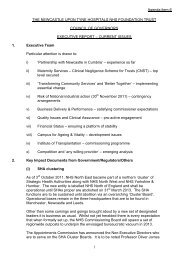
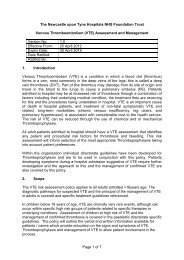
![Standard Precautions Policy - 112KB [PDF] - Newcastle Hospitals](https://img.yumpu.com/51150129/1/184x260/standard-precautions-policy-112kb-pdf-newcastle-hospitals.jpg?quality=85)
![Oxygen Management Policy - 38KB [PDF] - Newcastle Hospitals](https://img.yumpu.com/50798872/1/184x260/oxygen-management-policy-38kb-pdf-newcastle-hospitals.jpg?quality=85)
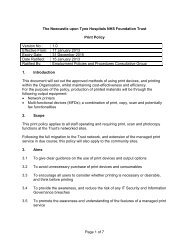
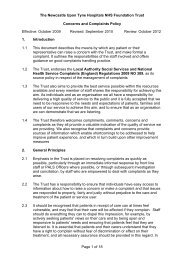
![Patient Identification Policy - 130KB [PDF] - Newcastle Hospitals](https://img.yumpu.com/49156101/1/190x245/patient-identification-policy-130kb-pdf-newcastle-hospitals.jpg?quality=85)
